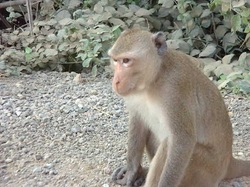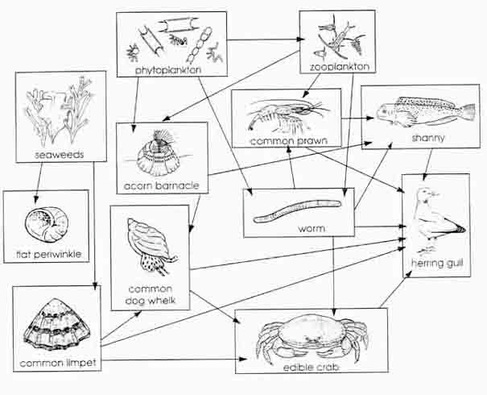What Wildlife Will I See There?
Diverse Wildlife
The Hundred Islands of the Phillipines is home to a wide variety of diverse organisms. Some species will exist on the land itself, such as the Monitor Lizard, Crab-Eating Macaque, and other land based animals. Those are listed below.
LAND SPECIES- Not part of Ocean Intertidal Zone, but present on the Hundred Islands

Monitor Lizard. HundredIslands.com. 2002.
Monitor Lizard
Crab-Eating Macaque

Crab-Eating Macaque. ThailandImages. 2010.
The Crab-Eating Macaque
Ocean Intertidal Zone Organisms
- Phytoplankton
- Algae
- Acorn Barnacle
- Zooplankton
- Crab
- Shanny
- Herring Gull
- Dugong
- Marine Bacteria
- Worms (Underwater)
- Red Sea Turtle
- Green Sea Turtle
- Common Dog Whelk
- Common prawn
- Herring Gull
Dugong
Classifying Organisms
There are several different groups into which marine organisms may be grouped. If they are in the marine ecosystem- meaning they are associated with a substrate or a water column), they are either BENTHIC or PELAGIC. (Pelagic means oceanic, literally.)
Type 1: Benthic
There are two different categories within the Benthic subcategory.
Type 2: Pelagic
Two types of organisms that are considered pelagic are as follows:
Plankton - These are tiny organisms that float in the water.
Either:
Photosynthetic (phytoplankton) - Also known as simple plants
or
Non photosynthetic (zooplankton) - Animal plankton
Nekton - These are organisms that move around independently in the water based on conscious drives for motion.
These include fish, the dugong, and other free swimming organisms.
Type 1: Benthic
There are two different categories within the Benthic subcategory.
- Hard Substrates- These are solid, stable organisms, such as coral reefs.
- Soft Muddy Substrate- These are organisms that are not stable; they move around and often bury under the ocean soil.
Type 2: Pelagic
Two types of organisms that are considered pelagic are as follows:
Plankton - These are tiny organisms that float in the water.
Either:
Photosynthetic (phytoplankton) - Also known as simple plants
or
Non photosynthetic (zooplankton) - Animal plankton
Nekton - These are organisms that move around independently in the water based on conscious drives for motion.
These include fish, the dugong, and other free swimming organisms.
The Food Chain
In every ecosystem, there is a food chain through which energy is transferred. In the Ocean Intertidal Zone, here is how the food chain breaks down:
Food chains in the Ocean Intertidal Zone of the world are generally regulated by nutrient concentrations. These concentrations determine the abundance of phytoplankton, which in turn provide food for the primary consumers, such as protozoa and zooplankton, that the higher-level consumers—fish, squid, and marine mammals—prey upon. This food chain is also known as the Pelagic Food Chain, on a microscopic level on the Ocean. See the picture below.
Producers
phytoplankton
algae
Acorn Barnacle
Zooplankton
Consumers
Crab
Shanny (Fish)
Herring Gull
Dugong
Decomposers
Marine Bacteria
Worms (Underwater)
Herbivores
Green Sea Turtle
Dugong
Red Sea Turtle
Carnivores
Common Dog Whelk
Common prawn
Shanny (Fish)
Top Carnivore
Herring Gull
On the Islands themselves, there will be other organisms, such as the Monitor Lizard and the Crab-Eating Macaque. (Listed at the top.) However, these are not part of the Ocean Intertidal Zone. By visiting the Hundred Islands, you are exposed to several different biomes at once!
The role of producers, consumers, and decomposers in the Intertidal Zone
The Intertidal Zone, just like any other ecosystem, requires transfers of energy in order to survive. These transfers of energy are made possible by the interactions between the producers, consumers, and decomposers of the Intertidal Zone.
The producers of the Intertidal Zone photosynthesize and convert sunlight into energy useable for themselves and other organisms (consumers). The consumers are essential to the process of energy transfer; there is a sense of mutualism in the relationship between animals and plants. (Animals spread the plants' seeds, while obtaining energy.) Finally, the cycle would not be possible without decomposers, because there would be no way to return the energy consumed by consumers and converted by plants to the soil and the environment from which the energy originated. In this way the cycle continues, just as it would in any other biome or ecosystem.
Food chains in the Ocean Intertidal Zone of the world are generally regulated by nutrient concentrations. These concentrations determine the abundance of phytoplankton, which in turn provide food for the primary consumers, such as protozoa and zooplankton, that the higher-level consumers—fish, squid, and marine mammals—prey upon. This food chain is also known as the Pelagic Food Chain, on a microscopic level on the Ocean. See the picture below.
Producers
phytoplankton
algae
Acorn Barnacle
Zooplankton
Consumers
Crab
Shanny (Fish)
Herring Gull
Dugong
Decomposers
Marine Bacteria
Worms (Underwater)
Herbivores
Green Sea Turtle
Dugong
Red Sea Turtle
Carnivores
Common Dog Whelk
Common prawn
Shanny (Fish)
Top Carnivore
Herring Gull
On the Islands themselves, there will be other organisms, such as the Monitor Lizard and the Crab-Eating Macaque. (Listed at the top.) However, these are not part of the Ocean Intertidal Zone. By visiting the Hundred Islands, you are exposed to several different biomes at once!
The role of producers, consumers, and decomposers in the Intertidal Zone
The Intertidal Zone, just like any other ecosystem, requires transfers of energy in order to survive. These transfers of energy are made possible by the interactions between the producers, consumers, and decomposers of the Intertidal Zone.
The producers of the Intertidal Zone photosynthesize and convert sunlight into energy useable for themselves and other organisms (consumers). The consumers are essential to the process of energy transfer; there is a sense of mutualism in the relationship between animals and plants. (Animals spread the plants' seeds, while obtaining energy.) Finally, the cycle would not be possible without decomposers, because there would be no way to return the energy consumed by consumers and converted by plants to the soil and the environment from which the energy originated. In this way the cycle continues, just as it would in any other biome or ecosystem.
How much energy flows through this ecosystem?
There are several key terms necessary to explain the vast amount of energy that cycles through the Philippines every day.
Key Terms:
Gross Primary Productivity - The total amount of productivity in a region or system
Net productivity- the amount of organic material available to support the consumers (herbivores and carnivores) of the sea.
Primary Productivity- the amount of biomass produced through photosynthesis per unit area and time by plants
Secondary Productivity - the rate of biomass formation or energy fixation by heterotrophic organisms
Gross Productivity- The total energy fixed by plants in a community through photosynthesis
Net Primary Productivity- The energy fixed by plants in a community through photosynthesis minus the energy used to perform metabolic processes for the plant.
For the Intertidal Zone of the Philippines, here are the specific applications of these terms.
Gross Primary Productivity would refer to the amount of energy made available to marine life through phytoplankton, cyanobacteria, and other photosynthesizing organisms in the ecosystem.
Net productivity applies to the total amount of energy transferred in the ecosystem.
Primary Productivity still refers to the amount of energy able to be produced by the plants and photosynthesizing organisms in the ecosystem.
Secondary productivity refers to how much energy the consumers use, or how efficient they are with their energy conversion.
Gross productivity alludes to the overall production of energy through the ecosystem, disregarding the effects of metabolic processes.
And finally, the net primary productivity still refers to the amount of energy produced by the plant minus the amount of that energy that the plant uses.
Key Terms:
Gross Primary Productivity - The total amount of productivity in a region or system
Net productivity- the amount of organic material available to support the consumers (herbivores and carnivores) of the sea.
Primary Productivity- the amount of biomass produced through photosynthesis per unit area and time by plants
Secondary Productivity - the rate of biomass formation or energy fixation by heterotrophic organisms
Gross Productivity- The total energy fixed by plants in a community through photosynthesis
Net Primary Productivity- The energy fixed by plants in a community through photosynthesis minus the energy used to perform metabolic processes for the plant.
For the Intertidal Zone of the Philippines, here are the specific applications of these terms.
Gross Primary Productivity would refer to the amount of energy made available to marine life through phytoplankton, cyanobacteria, and other photosynthesizing organisms in the ecosystem.
Net productivity applies to the total amount of energy transferred in the ecosystem.
Primary Productivity still refers to the amount of energy able to be produced by the plants and photosynthesizing organisms in the ecosystem.
Secondary productivity refers to how much energy the consumers use, or how efficient they are with their energy conversion.
Gross productivity alludes to the overall production of energy through the ecosystem, disregarding the effects of metabolic processes.
And finally, the net primary productivity still refers to the amount of energy produced by the plant minus the amount of that energy that the plant uses.
Soil
The soil in this ecosystem changes as one moves from the beach to the shallows of the water. The soil begins as a coarse to medium sand and gravel on the beach, which later turns into a fine sand. Later the texture turns to a sort of mixed sediments composition, then to mud, and finally to modern terrigenous and relict sediment. This refers to the texture of the soil.
The soil type is a sandy texture. It does not have the characteristics of the other soil types.
A sandy soil type supports producers in this biome by allowing them to have air pockets and space in the ground so as to allow them to grow better. Sandy soil, because it is made up of sediments, rocks, and other similar substances, also is rich in minerals, which means that these plants have an abundance of minerals and do not have to wait to have their nitrogen fixed before they can use it.
The soil type is a sandy texture. It does not have the characteristics of the other soil types.
A sandy soil type supports producers in this biome by allowing them to have air pockets and space in the ground so as to allow them to grow better. Sandy soil, because it is made up of sediments, rocks, and other similar substances, also is rich in minerals, which means that these plants have an abundance of minerals and do not have to wait to have their nitrogen fixed before they can use it.
Sources:
Rotondo, Marcia. "Ocean Soil Types". Ehow.com. 25 August 2010. Ehow. 26 Nov. 2010. <http://www.ehow.com/list_6904433_coastal-ocean-soil-types.html>.
"marine ecosystem." Encyclopædia Britannica. 2010. Encyclopædia Britannica Online. 29 Nov. 2010 <http://www.britannica.com/EBchecked/topic/365256/marine-ecosystem>.
"productivity." Encyclopædia Britannica. 2010. Encyclopædia Britannica Online. 29 Nov. 2010 <http://www.britannica.com/EBchecked/topic/246671/gross-primary-productivity>.
"Soil Types". Eais.net. 2010. Eais. 29 November 2010. <http://www.eais.net/soil/>.
Rotondo, Marcia. "Ocean Soil Types". Ehow.com. 25 August 2010. Ehow. 26 Nov. 2010. <http://www.ehow.com/list_6904433_coastal-ocean-soil-types.html>.
"marine ecosystem." Encyclopædia Britannica. 2010. Encyclopædia Britannica Online. 29 Nov. 2010 <http://www.britannica.com/EBchecked/topic/365256/marine-ecosystem>.
"productivity." Encyclopædia Britannica. 2010. Encyclopædia Britannica Online. 29 Nov. 2010 <http://www.britannica.com/EBchecked/topic/246671/gross-primary-productivity>.
"Soil Types". Eais.net. 2010. Eais. 29 November 2010. <http://www.eais.net/soil/>.
Copyright 2010 Meera Patel and Jo



